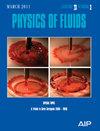Viscous effects on the hydrodynamic performance of a two-body wave energy converter with a damping plate
IF 4.3
2区 工程技术
Q1 MECHANICS
引用次数: 0
Abstract
In this study, the hydrodynamic forces and power absorption performance of an autonomous underwater vehicle (AUV)-based two-body wave energy converter (2BWEC) are investigated. A theoretical model is developed within the framework of linear potential flow to solve for added mass, radiation damping, and wave excitation force using the matched eigenfunction expansion method (MEEM). A computational fluid dynamics (CFD) model is employed to account for vortex-shedding effects of the floater and inner cylinder with a damping plate under various excitation conditions. Empirical formulas for supplementary added mass and drag coefficients caused by flow separation are proposed based on curve-fitting the differences between CFD results and MEEM calculations. These formulas are integrated into motion equations to enhance accuracy in evaluating the power absorption of the 2BWEC. It has been found that in the context of viscous flow, both the added mass and damping coefficients are increased, particularly for the inner cylinder with a damping plate. In addition, the viscous hydrodynamic coefficients exhibit strong dependence on the Keulegan–Carpenter number, while showing insensitivity to changes in the frequency parameter β. The supplementary (viscous) added mass provides additional inertia for the AUV with a limited mass itself, which is advantageous for the power absorption of the AUV-based 2BWEC. Conversely, the presence of viscous damping from the damping plate impedes wave energy capture.粘性效应对带有阻尼板的双体波浪能转换器水动力性能的影响
本研究探讨了基于自主潜水器(AUV)的双体波浪能转换器(2BWEC)的流体动力和功率吸收性能。在线性势流框架内建立了一个理论模型,利用匹配特征函数展开法(MEEM)求解了附加质量、辐射阻尼和波激力。采用计算流体动力学(CFD)模型来考虑各种激励条件下浮筒和带有阻尼板的内圆筒的涡流剪切效应。根据 CFD 结果与 MEEM 计算结果之间差异的曲线拟合,提出了由流动分离引起的附加质量和阻力系数的经验公式。这些公式被整合到运动方程中,以提高评估 2BWEC 功率吸收的准确性。研究发现,在粘性流动的情况下,附加质量和阻尼系数都会增加,特别是对于带有阻尼板的内筒。此外,粘性流体力学系数与 Keulegan-Carpenter 数有很大关系,但对频率参数 β 的变化不敏感。附加(粘性)质量为 AUV 提供了额外的惯性,而 AUV 本身的质量有限,这有利于基于 AUV 的 2BWEC 吸收功率。相反,阻尼板产生的粘性阻尼会阻碍波能捕获。
本文章由计算机程序翻译,如有差异,请以英文原文为准。
求助全文
约1分钟内获得全文
求助全文
来源期刊

Physics of Fluids
物理-力学
CiteScore
6.50
自引率
41.30%
发文量
2063
审稿时长
2.6 months
期刊介绍:
Physics of Fluids (PoF) is a preeminent journal devoted to publishing original theoretical, computational, and experimental contributions to the understanding of the dynamics of gases, liquids, and complex or multiphase fluids. Topics published in PoF are diverse and reflect the most important subjects in fluid dynamics, including, but not limited to:
-Acoustics
-Aerospace and aeronautical flow
-Astrophysical flow
-Biofluid mechanics
-Cavitation and cavitating flows
-Combustion flows
-Complex fluids
-Compressible flow
-Computational fluid dynamics
-Contact lines
-Continuum mechanics
-Convection
-Cryogenic flow
-Droplets
-Electrical and magnetic effects in fluid flow
-Foam, bubble, and film mechanics
-Flow control
-Flow instability and transition
-Flow orientation and anisotropy
-Flows with other transport phenomena
-Flows with complex boundary conditions
-Flow visualization
-Fluid mechanics
-Fluid physical properties
-Fluid–structure interactions
-Free surface flows
-Geophysical flow
-Interfacial flow
-Knudsen flow
-Laminar flow
-Liquid crystals
-Mathematics of fluids
-Micro- and nanofluid mechanics
-Mixing
-Molecular theory
-Nanofluidics
-Particulate, multiphase, and granular flow
-Processing flows
-Relativistic fluid mechanics
-Rotating flows
-Shock wave phenomena
-Soft matter
-Stratified flows
-Supercritical fluids
-Superfluidity
-Thermodynamics of flow systems
-Transonic flow
-Turbulent flow
-Viscous and non-Newtonian flow
-Viscoelasticity
-Vortex dynamics
-Waves
 求助内容:
求助内容: 应助结果提醒方式:
应助结果提醒方式:


